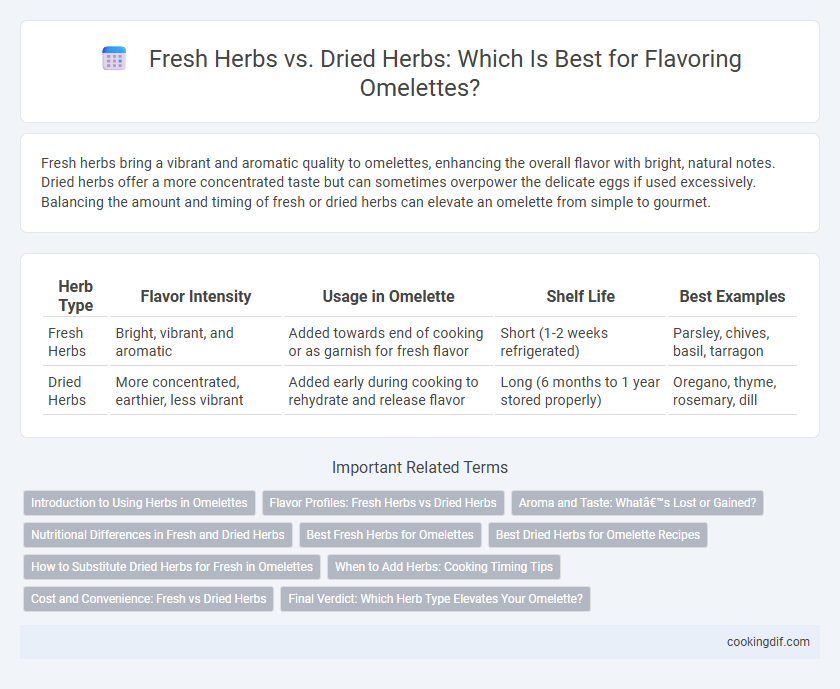Fresh herbs bring a vibrant and aromatic quality to omelettes, enhancing the overall flavor with bright, natural notes. Dried herbs offer a more concentrated taste but can sometimes overpower the delicate eggs if used excessively. Balancing the amount and timing of fresh or dried herbs can elevate an omelette from simple to gourmet.
Table of Comparison
| Herb Type | Flavor Intensity | Usage in Omelette | Shelf Life | Best Examples |
|---|---|---|---|---|
| Fresh Herbs | Bright, vibrant, and aromatic | Added towards end of cooking or as garnish for fresh flavor | Short (1-2 weeks refrigerated) | Parsley, chives, basil, tarragon |
| Dried Herbs | More concentrated, earthier, less vibrant | Added early during cooking to rehydrate and release flavor | Long (6 months to 1 year stored properly) | Oregano, thyme, rosemary, dill |
Introduction to Using Herbs in Omelettes
Fresh herbs like chives, parsley, and tarragon deliver vibrant, aromatic flavors that elevate omelette texture and taste, while dried herbs offer concentrated, intense flavors but can overwhelm if overused. Incorporating fresh herbs near the end of cooking preserves their bright, natural flavor, whereas dried herbs benefit from early addition to release their essential oils. Balancing these herb types enhances omelette complexity, allowing chefs to customize flavors for a perfectly seasoned dish.
Flavor Profiles: Fresh Herbs vs Dried Herbs
Fresh herbs like chives, parsley, and basil provide bright, vibrant flavors and a fresh aroma that enhance an omelette's taste, offering a delicate, nuanced profile. Dried herbs, concentrated through dehydration, deliver a more intense, earthy flavor but can overpower the subtle eggs if used excessively. Balancing the use of fresh and dried herbs allows for a customized flavor profile, with fresh herbs typically added at the end of cooking to preserve their freshness and dried herbs incorporated earlier to meld with the eggs.
Aroma and Taste: What’s Lost or Gained?
Fresh herbs like basil, chives, and parsley provide a vibrant aroma and a bright, nuanced taste that enhances the delicate flavor of an omelette. Dried herbs, while more concentrated in flavor, often lose essential oils during the drying process, resulting in a muted aroma and a slightly bitter, less complex taste. Using fresh herbs preserves the natural oils responsible for freshness and aroma, creating a more flavorful and aromatic omelette experience.
Nutritional Differences in Fresh and Dried Herbs
Fresh herbs in omelettes provide higher levels of vitamin C and antioxidants compared to dried herbs, which often lose some nutritional value during the drying process. Dried herbs, however, contain more concentrated minerals like iron and calcium due to moisture removal, making them nutrient-dense per gram. Incorporating both fresh and dried herbs can balance flavor intensity while enhancing the nutritional profile of omelettes.
Best Fresh Herbs for Omelettes
Fresh herbs like chives, parsley, and tarragon enhance omelette flavor with vibrant, natural aromas and more nuanced taste profiles compared to dried herbs. Chives bring a mild onion flavor, parsley adds a bright, slightly peppery note, and tarragon contributes a subtle anise-like essence that complements eggs perfectly. Using fresh herbs preserves essential oils and textures, resulting in a more flavorful and visually appealing omelette.
Best Dried Herbs for Omelette Recipes
Dried herbs such as oregano, thyme, and chives are ideal for flavoring omelettes due to their concentrated taste and long shelf life. These herbs maintain their potency during cooking, providing a robust and consistent flavor compared to fresh herbs, which can lose intensity when heated. Incorporating dried basil, tarragon, or parsley can elevate the omelette's taste, ensuring a well-balanced and aromatic dish.
How to Substitute Dried Herbs for Fresh in Omelettes
When substituting dried herbs for fresh in omelettes, use one-third the amount of dried herbs compared to fresh, as dried herbs have a more concentrated flavor. To enhance the aroma and flavor, crumble dried herbs between your fingers before adding them to the egg mixture, and add them early in the cooking process to allow their flavors to infuse. Fresh herbs like chives, parsley, and tarragon provide a bright taste, but dried versions can offer a robust alternative when fresh herbs are unavailable.
When to Add Herbs: Cooking Timing Tips
Fresh herbs like chives, parsley, and tarragon added at the end of cooking preserve their vibrant flavor and aroma in omelettes, while dried herbs such as oregano or thyme benefit from early incorporation to fully release their taste during cooking. Timing is crucial: fresh herbs should be sprinkled just before serving or folded in gently at the end to avoid bitterness and moisture loss. Dried herbs integrate best when mixed with eggs before cooking, allowing their essential oils to infuse the omelette for a deeper, more balanced flavor.
Cost and Convenience: Fresh vs Dried Herbs
Fresh herbs, such as chives, parsley, and basil, offer vibrant flavor and aroma for omelettes but tend to be more expensive and have a shorter shelf life compared to dried herbs. Dried herbs provide convenience, longer storage, and cost-effectiveness, making them ideal for quick seasoning despite a less intense flavor profile. Choosing between fresh and dried herbs depends on budget constraints and time availability, with fresh herbs favored for gourmet preparation and dried herbs preferred for everyday cooking.
Final Verdict: Which Herb Type Elevates Your Omelette?
Fresh herbs such as basil, chives, or parsley offer vibrant, aromatic flavors that infuse an omelette with brightness and freshness, enhancing its overall appeal. Dried herbs, while more concentrated and shelf-stable, tend to deliver a deeper, earthier taste but may lack the lively nuance fresh herbs provide. For an elevated omelette experience, fresh herbs are typically preferred for their superior flavor intensity and texture, making them the optimal choice for elevating your dish.
Fresh herbs vs dried herbs for omelette flavoring Infographic

 cookingdif.com
cookingdif.com